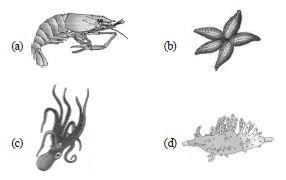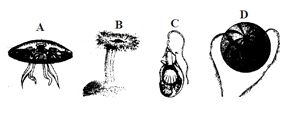Match the types of animals given in column I with their examples given in column II and choose the correct option.
| Column -I | Column -II |
|---|---|
| (Types of animals) | (Examples) |
| A. Limbless reptiles | I. Elephant |
| B. Jawless vertebrates | II. Lamprey |
| C. Flightless bird | III. Ichthyophis |
| D. Largest | IV. Ostrich terrestrial animal |
| E. Limbless amphibia | V. Cobra |
A II; B V; C IV; D I; E III
A V; B II; C IV; D I; E III
A V; B II; C I; D IV; E III
A V; B IV; C II; D I; E III
Correct Answer :
B. A V; B II; C IV; D I; E III
Related Questions
Which one of the following categories of animals is correctly described with no single exception in it?
In chondrichthyes notochord is persistent throughout life.
All mammals are viviparous and possess diaphragm for breathing.
All sponges are marine.
All reptiles possess scales, have a three chambered heart and are cold blooded (poikilothermal).
Which of the following is not the common fundamental feature for animal classification?
Germinal layers.
Pathway of water transport.
Pattern of organization of cells.
Serial repetition of the segments.
Which of the following animal's body is covered by calcareous shell and unsegmented with a distinct head, muscular foot, and visceral hump?

Click to check answer
Click to check answer
Click to check answer
Click to check answer
Refer the given figures A, B, C and D and identify the option which shows their correct name.

A - Pleurobrachia, B - Cnidoblast, C - Aurelia, D - Adamsia
A - Aurelia, B - Adamsia, C - Cnidoblast, D - Pleurobrachia
A - Cnidoblast, B - Pleurobrachia, C - Adamsia, D - Aurelia
A - Adamsia, B - Aurelia, C - Pleurobrachia, D - Cnidoblast
A file like rasping organ for feeding, called radula, present in the phylum __________.
arthropoda
mollusca
echinodermata
chordata
Which of the following is a correct match of a phylum with their three examples?
PlatyhelminthesPlanaria, Schistosoma, Enterobius
Mollusca Loligo, Sepia, Octopus
Porifera Spongilla, Euplectella, Pennatula
Cnidaria Bonellia, Physalia, Aurelia
Heart is three - chambered in reptiles, except
turtle
Chameleon
Naja (Cobra)
crocodile
Column I contains zoological names of animals and column II contains their common name. Match the following and choose the correct option.
| Column -I | Column- II |
|---|---|
| A. Physalia | I. Sea anemone |
| B. Meandrina | II. Brain coral |
| C. Gorgonia | III. Sea fan |
| D. Adamsia | IV. Portuguese man-of-war |
A III; B II; C I; D IV
A IV; B III; C II; D I
A IV; B II; C III; D I
A II; B III; C I; D IV
Refer the figures A, B, C and D given below. Which of the following options shows the correct name of the animals shown by the figures A, B, C and D ?

A – Locust, B – Scorpion, C – Prawn, D – Pila
A – Locust, B – Prawn, C – Scorpion, D – Pila
A – Locust, B – Scorpion, C – Prawn, D – Snail
A – Butterfly, B – Scorpion, C – Prawn, D – Pila
Which of the following possesses electric organs and belongs to class chondrichthyes?
Torpedo
Petromyzon
Trygon
Exocoetus
Select the incorrect feature of mollusca from the given statements.
- Terrestrial or aquatic animals having cellular system level of organization.
- Radial symmetrical and acoelomate animals and possesses two germinal layers.
- A file like rasping organ called radula is present.
- Usually dioecious and viviparous animals.
- Examples include Pila, Octopus, and Dentalium.
(i) and (ii) only
(ii) and (iv) only
(i), (ii) and (iv) only
All the five statements.
Which of the following animals are bilaterally symmetrical?

1 & 2
2 & 4
3 & 4
1 & 3
Match the organisms given in column-I with their common name given in column-II and choose the correct option.
| Column -I | Column -II |
|---|---|
| (Organisms) | (Comman name) |
| A. Pennatula | I. Sea-lily |
| B. Antedon | II. Sea- pen |
| C. Echinus | III. Sea-urchin |
| D. Cucumaria | IV. Sea - cucumber |
A II; C III; D I; E IV
A II; C IV; D I; E III
A II; C I; D III; E IV
A II; C I; D III; E IV
The given figures (A & B) shows the germinal layer. The animals having structures shown in the figures are respectively called

diploblastic, triploblastic
triploblastic, diploblastic
diploblastic, diploblastic
triploblastic, triploblastic
Which of the following phylum is being described by the given statements?
(i) They are bilaterally symmetrical,triploblastic, segmented and coelomate animals.
(ii) The body consists of head, thorax, abdomen and have jointed appendages.
(iii) Circulatory system is of open type.
(iv) Excretion takes place through malphigian tubules.
Arthropoda
Annelida
Mollusca
Echinodermata
The combination of a true coelom and repeating body segmentation allows the annelids (unlike the anatomically simpler worms) to do which of the following?
Attain complex body shapes and thus locomote more precisely.
Move through loose marine sediments.
Be hermaphroditic.
Inject paralytic poisons into their prey.
Which of the following group of animals reproduces only by sexual means?
Ctenophora
Cnidaria
Porifera
Protozoa
Match the terms/feature given in column I with their examples given in column II and select the correct match from the option given below.
| Column-I | Column-II |
|---|---|
| (Term/Feature) | (Examples) |
| A. Gregarious pest | i. Hirudinaria |
| B. Vector | ii. Planaria |
| C. Oviparous with | iii. Sepia indirect development |
| D. Metameres | iv. Aedes |
| E. High regeneration | v. Locust capacity |
A - i, B - ii, C - iii, D - iv, E - v
A - iii, B - v, C - ii, D - iv, E - i
A - iii, B - i, C - v, D - ii, E - iv
A - v, B - iv, C - iii, D - i, E - ii
A common characteristic of all vertebrates without exception is
the division of body into head, neck, trunk and tail.
body covered with exoskeleton.
the possession of two pairs of functional appendages.
the presence of well- developed skull.
The organisms attached to the substratum generally possess
one single opening to the digestive canal.
cilia on the surface to create water current.
radial symmetry.
asymmetrical body.
Which of the following feature is not correct regarding the figure given below?

It is an aquatic form.
Circulatory system is of open type.
It possesses parapodia for swimming.
Neural system consists of paired ganglia connected by lateral nerves to a double ventral nerve cord.
Flame cells present in platyhelminthes, are specialized in
respiration and absorption.
osmoregulation and circulation.
respiration and excretion.
osmoregulation and excretion.
Which of the following statement(s) is/are correct for class amphibia?
(i) Body is divisible into head and trunk.
(ii) Respiration is through gills only.
(iii) The heart is two chambered i.e. one auricle and one ventricle.
(iv) Fertilization is internal.
Only (i)
Only (iv)
(i), (ii) and (iii)
All of these
Which of the following is not a characteristic of phylum echinodermata ?
They have a water vascular system.
They have an internal skeleton.
They are protostomes.
They have bilateral symmetry at larval stage.
Which of the following is an incorrect statement regarding flatworms ?
They are acoelomates.
They are bilaterally symmetrical.
They lack a digestive system.
They have a circulatory system.
Which of the following statement(s) is/are correct regarding class aves?
(i) The forelimbs are modified into wings and the hindlimbs generally have scales and are modified for walking, swimming or clasping the tree branches.
(ii) Heart is completely four-chambered.
(iii) They are warm- blooded (homoiothermous) animals i.e., they are able to maintain a constant body temperature.
(iv) They are oviparous and development is direct.
Both (i) and (iii)
Both (i) and (iv)
(i), (ii) and (iii)
All of these
Which of the following pairs of animals comprises jawless fishes?
Mackerals and rohu
Lampreys and hag fishes
Guppies and hag fishes
Lampreys and eels
Column-I contains organisms and column-II contains their exeretory structures. Choose the correct match form the options given below.
| Column- I | Column -II |
|---|---|
| (Organism) | (Excretory structures) |
| A. Cockroach | I. Nephridia |
| B. Cat fish | II. Malpighian tubules |
| C. Earthworm | III. Kidneys |
| D. Balanoglossus | IV. Flame cells |
| E. Flatworm | V. Proboscis gland |
A I; B III; C II; D IV; E V
A III; B I; C II; D V; E IV
A II; B I; C III; D V; E IV
A II; B III; C I; D V; E IV
In amphibians, respiration occurs through
gills
lungs
skin
all of these
Which of the following features distinguish mammals from other vertebrates ?
Hairy skin and oviparity
Hairy skin and mammary glands
Mammary glands and teeth
Pinna and teeth
